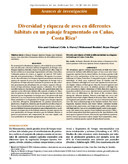| dc.description.abstract | Se caracterizó la abundancia, riqueza y diversidad de aves en hábitats con diferente cobertura arbórea (fragmentos de bosque seco, bosques riparios, charrales, cercas vivas, potreros de alta y baja cobertura arbórea) en un paisaje fragmentado en Cañas, Costa Rica. Utilizando puntos de conteo, se registró un total de 3037 individuos de aves pertenecientes a 29 familias y 80 especies. De acuerdo al índice de Shannon, los potreros de alta cobertura y los bosques riparios son más diversos que los fragmentos de bosque seco y los potreros de baja cobertura. Las aves insectívoras fueron las más comunes en los hábitats estudiados. Los fragmentos de bosque seco, bosques riparios y charrales albergaron principalmente los gremios nectarívoros, piscívoros y frugívoros, mientras que los potreros de alta y baja cobertura fueron dominados por las carnívoras, granívoras y omnívoras. The abundance, species richness and diversity of birds were characterized in habitats with different types of tree cover (dry forest fragments, riparian forests, forest fallows, live fences, pasture with high tree cover and pastures of low tree cover) in a fragmented landscape in Cañas, Costa Rica. Using point counts, a total of 3037 individuals of birds were registered from 29 families and 80 species.Pastures with high tree cover and riparian forests had a higher Shannon diversity index than dry forest fragments and pastures with low tree cover. Insectivorous birds were the most common group in the habitats studied. Dry forest fragments, riparian forests and forest fallows contained mainly nectarivorous, piscivorous, and frugivorous guilds, while pastures with high and low tree cover contained mainly carnivorous, granivorous and omnivorous species. | es_ES |



